Despite growing concerns about the continued presence of US strategic bombers at Guam, a flight of two B-1 Lancer strategic bombers conducted a quick training dash to Alaska via Japan to provide a rapid response, flexible strategic strike training capability for the joint force.
To continue reading the rest of this article, please log in.
Create free account to get unlimited news articles and more!
In Alaska, the B-1s were joined by F-22s and F-16s out of the 3rd Wing at Joint Base Elmendorf-Richardson to conduct a large force employment exercise in the Joint Pacific Alaska Range Complex.
The crews then flew southwest to Japan where they completed familiarisation training in support of US European Command objectives.
The bombers then continued south in the vicinity of Misawa, Japan, integrating with the USS Ronald Reagan and a P-8 Poseidon to conduct Long Range Anti-Ship Missile training before returning to Guam.
The B-1s and Airmen are currently deployed to Andersen AFB from 9th Expeditionary Bomb Squadron, 7th Bomb Wing, Dyess Air Force Base, Texas, as part of a joint US Indo-Pacific Command (INDOPACOM) and US Strategic Command Bomber Task Force (BTF).
Lieutenant Colonel Ryan Stallsworth, 9th EBS commander, explained the importance of such missions, stating, “These missions demonstrate our ability to hold any target at risk, anytime and anywhere.
“The training value of these sorties is irreplaceable… Our team conducted large force exercise training around Alaska with US Air Force fighters. We conducted multiple standoff weapons training events, as well as integrated with US naval assets along the way. From a readiness perspective, it is hard to think of a more valuable training sortie,” LTCOL Stallsworth added.
In line with the National Defense Strategy’s objectives of strategic predictability and operational unpredictability, the US Air Force transitioned its force employment model to enable strategic bombers to operate forward in the Indo-Pacific region from a broader array of overseas and continental US locations with greater operational resilience.
B-1s first returned to the theater on 22 January, conducting a long-range BTF mission from Ellsworth AFB, South Dakota, to integrate with US Air Force F-16s and Koku Jieitai, or Japan Air Self Defense Force (JASDF) F-2s and F-15s.
The Airmen and crews from Dyess arrived at Andersen AFB on 1 May to conduct BTF missions in the Indo-Pacific.
Since their arrival, they have conducted a variety of missions, from near the Hawaiian Islands to the South China Sea, integrating with both joint counterparts and JASDF partners.
Flying this type of mission allows B-1 crews to gain valuable training in being able to familiarise with air bases and operations in different Geographic Combatant Commands’ areas of operations.
Lieutenant Colonel Frank Welton, Pacific Air Forces’ chief of operations force management, added, “This shows the ability of the US to reach anywhere on the globe and synchronise operations with other Geographic Combatant Commands.”
From the moment a plan is drawn up, to execution, landing and maintenance, BTF missions such as this one take a team effort from across the Air Force in order to demonstrate the United States’ steadfast commitment to the security and stability of the Indo-Pacific region.
Stephen Kuper
Steve has an extensive career across government, defence industry and advocacy, having previously worked for cabinet ministers at both Federal and State levels.

 Login
Login








